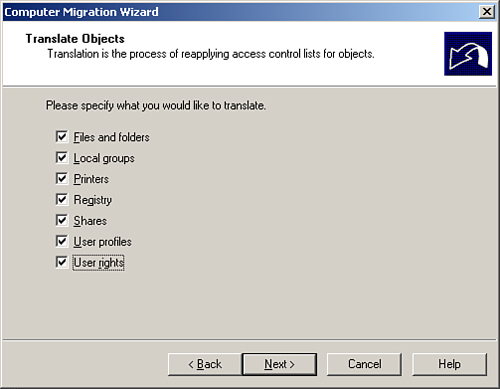Migrating Computer
Accounts
Another important set of
objects that must be migrated is also one of the trickier ones. Computer
objects must not only be migrated in AD, but they must also be updated
at the workstations themselves so that users will be able to log on
effectively from their consoles. ADMT seamlessly installs agents on all
migrated computer accounts and reboots them, forcing them into their new
domain structures.
The account running the ADMT
must have local administrator rights to the computers being migrated.
The agents must also be accessible over the network, so any firewalls
should be disabled for the migration or grant exceptions.
Follow these steps to
migrate computer accounts:
1. | Open the
ADMT MMC snap-in (Start, Administrative Tools, Active Directory
Migration Tool).
|
2. | Right-click
the Active Directory Migration Tool, and choose Computer Migration
Wizard.
|
3. | Click Next
on the Welcome page.
|
4. | Type the names of the source and destination domains in
the drop-down boxes on the next page, and click Next to continue.
|
5. | Choose the Select Computers from Domain option, and
click Next.
|
6. | On the
following page, select the computer accounts that will be migrated by
clicking the Add button and selecting the appropriate accounts. Click
Next to continue.
|
7. | Select
the OU the computer accounts will be migrated to, and click Next to
continue.
|
8. | The next
Translate Objects page allows for the option to specify which settings
on the local clients will be migrated. Click the Help button for a
detailed description of each item. In this example, select all items, as
shown in Figure 3. Click Next to continue.

|
9. | The
subsequent page prompts to choose whether existing security will be
replaced, removed, or added to. In this example, replace the security.
Click Next to continue.
|
10. | A prompt then informs you that the user rights
translation will be performed in Add mode only. Click OK to continue.
|
11. | The next page is important, as it allows an
administrator to specify how many minutes a computer will wait before
restarting itself (the default is 5 minutes). Click Next to continue.
|
12. | Just as in the previous wizards, exclusions can be
set for specific attributes in the following wizard page. Select any
exclusions needed and click Next to continue.
|
13. | Naming conflicts are addressed on the subsequent page.
If any specific naming conventions or conflict resolution settings are
required, enter them here. Click Next to continue.
|
14. | The Completion page lists a summary of the changes that
will be made. Review the list and click Finish when you are ready. All
clients that will be upgraded are subsequently rebooted.
|
15. | When the migration process is complete, you can view
the Migration log by clicking the View Log button. After verifying all
settings, click Close.
|
16. | The ADMT Agent Dialog window opens. This tool allows the
administrator to control the agent operations. Click Start to run
pre-check. This identifies any potential issues with the agent
migration. The results of the pre-check will be displayed in the
Pre-check column. Verify that all computers passed.
|
17. | In the Agent Actions box, select the Run Pre-check and
Agent Operations option button. Then click Start to perform the
migration operations.
|
18. | The client agents are subsequently distributed to all
clients that have been migrated. Click Close on the ADMT MMC snap-in to
end the wizard.
|
Each agent is installed
automatically and counts down until the designated time limit set during
the configuration of the Computer Migration Wizard. Then the migrated
computers reboot into the new domain with the designated settings
migrated.